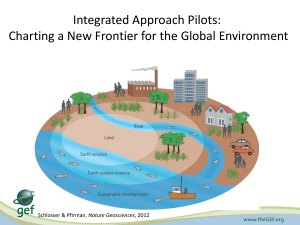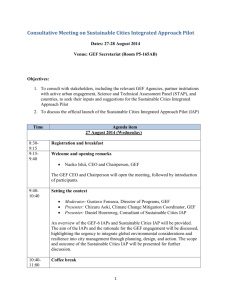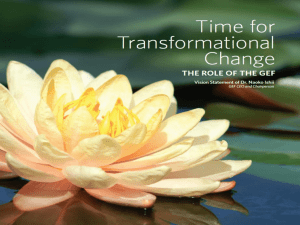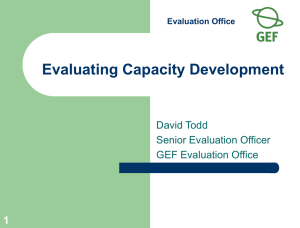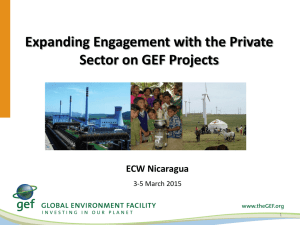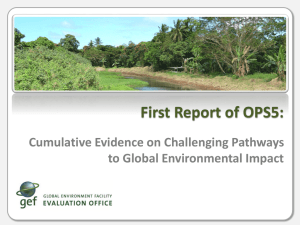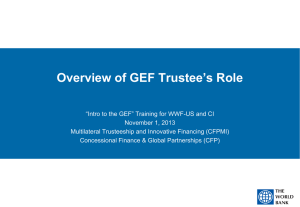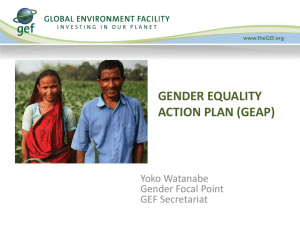Minutes of the meeting - Global Environment Facility
advertisement
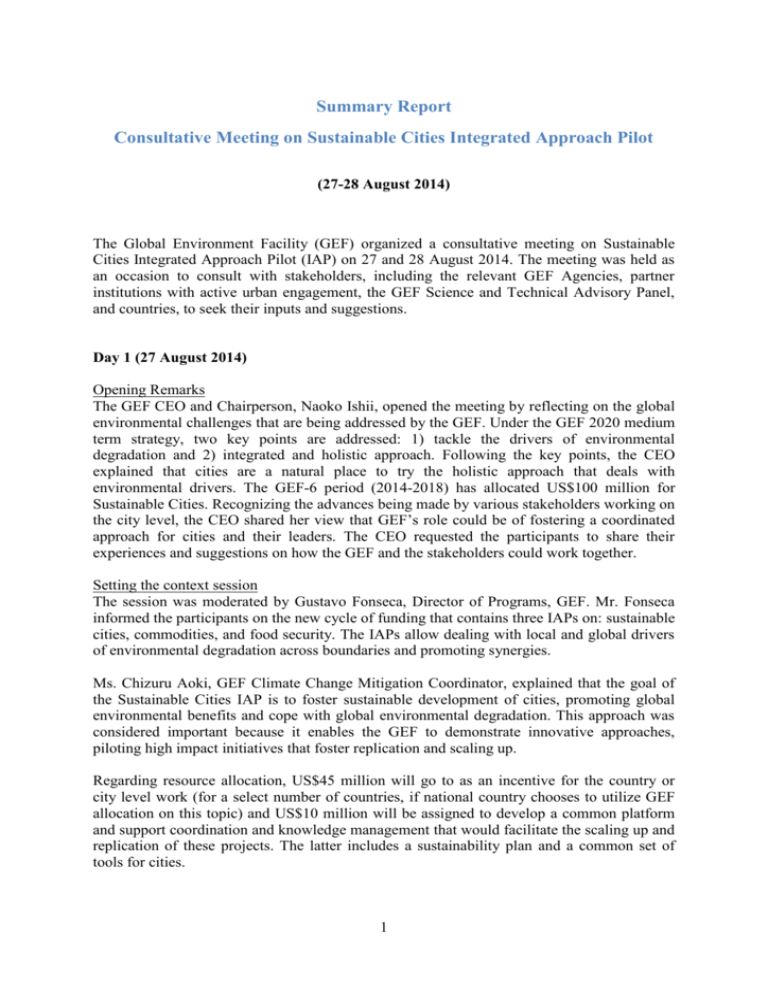
Summary Report Consultative Meeting on Sustainable Cities Integrated Approach Pilot (27-28 August 2014) The Global Environment Facility (GEF) organized a consultative meeting on Sustainable Cities Integrated Approach Pilot (IAP) on 27 and 28 August 2014. The meeting was held as an occasion to consult with stakeholders, including the relevant GEF Agencies, partner institutions with active urban engagement, the GEF Science and Technical Advisory Panel, and countries, to seek their inputs and suggestions. Day 1 (27 August 2014) Opening Remarks The GEF CEO and Chairperson, Naoko Ishii, opened the meeting by reflecting on the global environmental challenges that are being addressed by the GEF. Under the GEF 2020 medium term strategy, two key points are addressed: 1) tackle the drivers of environmental degradation and 2) integrated and holistic approach. Following the key points, the CEO explained that cities are a natural place to try the holistic approach that deals with environmental drivers. The GEF-6 period (2014-2018) has allocated US$100 million for Sustainable Cities. Recognizing the advances being made by various stakeholders working on the city level, the CEO shared her view that GEF’s role could be of fostering a coordinated approach for cities and their leaders. The CEO requested the participants to share their experiences and suggestions on how the GEF and the stakeholders could work together. Setting the context session The session was moderated by Gustavo Fonseca, Director of Programs, GEF. Mr. Fonseca informed the participants on the new cycle of funding that contains three IAPs on: sustainable cities, commodities, and food security. The IAPs allow dealing with local and global drivers of environmental degradation across boundaries and promoting synergies. Ms. Chizuru Aoki, GEF Climate Change Mitigation Coordinator, explained that the goal of the Sustainable Cities IAP is to foster sustainable development of cities, promoting global environmental benefits and cope with global environmental degradation. This approach was considered important because it enables the GEF to demonstrate innovative approaches, piloting high impact initiatives that foster replication and scaling up. Regarding resource allocation, US$45 million will go to as an incentive for the country or city level work (for a select number of countries, if national country chooses to utilize GEF allocation on this topic) and US$10 million will be assigned to develop a common platform and support coordination and knowledge management that would facilitate the scaling up and replication of these projects. The latter includes a sustainability plan and a common set of tools for cities. 1 Mr. Daniel Hoornweg, consultant for Sustainable Cities IAP, reflected on how cities have become a center of consumption and driver of environmental degradation, but that give the opportunity to develop a common and integrated approach for sustainable development. On the analysis of cities, several approaches were highlighted, including the abatement costs curve, the metabolism analysis and the urban ecosystems approach. The discussion generated the following suggestions and insights: a. Working with cities is different than working with national governments. It was suggested that the co-benefits for cities should be highlighted, as it will increase the interest of mayors and city leaders. b. Consider short-term deliverables. In developing countries, frequent political turnovers are a major barrier to long-term and large-scale urban infrastructure investment. Having short-term deliverables will increase mayor’s support. c. There is a disconnect between resources that go to national ministry to address urban issues and resources that cities receive. The need for more direct financing for cities was highlighted. d. Avoid a top-down only approach and look for bottom-up support. The proposed sustainability plan’s vision needs to be shared with the population, and mayors need to utilize the platform to foster the vision. e. Consider different sizes of cities. Several participants called for the inclusion of medium- and small-sized cities and fast-growing cities in the Sustainable Cities IAP. f. Have flexibility on the metropolitan approach. The participants suggested to carefully consider the power and authority of metropolitan governments, as some might be weak to implement measures. g. Retain flexibility on partners. In some cases, sectorial authorities might facilitate work at the local level, while in other cases there may be tension between the local and national governments. h. Common data might be difficult to obtain from cities. Some participants questioned why the IAP has an emphasis on common data. The GEF noted this and considered the need for some level of harmonization to enable learning beyond a specific case. i. Consider cities that are not saturated with international cooperation. The GEF responded by highlighting the need for global environmental benefits that maximize the investments. j. A common platform will be very useful for sharing experiences. For the consolidation of data, there should be consultations with mayors. k. Review link between urban and rural spheres. Cities depend on rural areas for the food security. Common global framework and potential for cooperation session (part I) The session was moderated by Daniel Hoornweg, who discussed the need for a common framework to help build sustainable cities. Ms. Cristina Rumbaitis del Rio, Senior Associate Director of Urban Climate Change Resilience Partnership, Rockefeller Foundation, gave a presentation that recalled the barriers to access finance for cities. She suggested the GEF to look at the theory of change for cities, and recommended investing in upstream tools that can unlock downstream outcomes for cities. Furthermore, she advised the GEF to work with second-tier cities or fast growing cities as the possibility for investing in resilience infrastructure is readily available. 2 Mr. Gino Van Begin, Secretary General of ICLEI, discussed the importance of socializing a sustainability plan with a city’s population for its success. He suggested that GEF build on existing city plans (e.g. land use plan) to have a holistic approach on cities that can be implemented. Based on the experience of Local Agenda 21, he suggested that GEF measures the success of city sustainable development policies. Mr. Zach Tofias, Director of C40 Sustainable Communities Initiative and C40 Climate Positive Development Program, discussed C40’s global network of cities that have megacities and smaller cities working together on six working areas: energy, solid waste, transportation, adaptation and resilience, sustainable communities and finance and economic development. He stated that one of the main current challenges for cities is to access the wanted technical support within the specific time frames of mayors. Mr. Vijay Jagannathan, Senior Advisor of World Resources Institute (WRI), recalled the two narratives for cities: one that focuses on the mitigation effects of city planning and climate friendly investments and another narrative on risks that calls more the attention of citizens. With the latter narrative, city political leaders understand the ideas and relevance/rationale to act quickly. Emphasizing this narrative would be a good way to approach the city leaders. Ms. Patricia McCarney, Director of World Council on City Data, presented the process and challenges to the development of ISO37120 for cities. She highlighted that the geographic boundaries do not match the administrative ones, that there are not standardized definitions on what and how to measure and the lack of mechanism for data and knowledge sharing across cities. The discussion generated the following suggestions and insights: a. Integrating science and knowledge generated about cities in the decision making process. b. Recognize different priorities of cities. Cities all have their competitive advantages and disadvantages. Therefore their priorities are different. c. Need to address the quality of indicators. While there are more consensuses on climate change mitigation indicators and their quality, other indicators’ quality varies considerably. d. Introducing indicators in a sensitive manner. Consideration of economic issues, time required and previous indicators was raised. e. Engaging the private sector. Engaging private investors to replicate and enhance scaling up was indicated as a priority. f. Using existing plans. The GEF should utilize urban land-use plans that are available instead of starting with planning from zero. Common global framework and potential for cooperation session (part II) The session started with remarks by Ms. Rosina Bierbaum, Chairperson of STAP, who discussed proliferation of urban centers, their impact on the world’s environment and the potential role of the GEF. During the afternoon session, dialogue continued to provide feedback on the common framework-platform and cooperation. The main points discussed include the following: 3 a. Addressing global environmental commons in an integrated way. STAP participants mentioned that while GEF tackles environmental global commons, its work on cities may allow foster environmental development in an integrated way for transformational change in the long term. i. On this matter the World Bank supported the idea that the GEF has to maximize their investments and a way forward is to trigger other investments for sustainability of cities. ii. Some participants asked if adaptation measures would count as global environmental benefits. Hence, it was suggested to revise the definition of ‘global environmental benefits’. b. Collecting data. The importance of collecting information about the GEF outcomes was highlighted. i. It was also mentioned that there should be a reasonable number of indicators, and that these ones should have good quality. c. Size of cities that need support. For the US context, it was mentioned that big cities often have more capacities to think about resilience than small cities. i. UNDP mentioned that it is easier to work with smaller cities. ii. Some participants commented that larger cities may be more relevant for replication and impact. Also, the limited resource availability may mean that small investments in too many small cities may not amount to much. d. Cities as an opportunity to encourage countries to make their nationally determined contributions (NDCs). Cities have many opportunities to act and many are using their opportunities, both in adaptation and in mitigation. These opportunities can be used as building blocks for climate negotiations leading towards the Paris climate negotiations in 2015. e. Involving scientists with policymakers to discuss cities topics. It was suggested that GEF could leverage its unique position to connect scientists with policymakers at both the central and local levels. f. Tailoring the message to include topics that are relevant for mayors. Fire, water and safety are such relevant topics that may be used when approaching mayors. i. UNDP mentioned the importance of managing the cities expectations on the process for sustainability. ii. WWF-US declared that a way forward is to have dialogues within cities that help the process for a sustainability plan. g. Eligibility criteria. Several participants suggested having flexibility on the eligibility criteria for the pilot programs. i. Conservation International pointed out having a sustainability plan as a criterion. ii. A competition element was suggested so cities could demonstrate how they would achieve measurable results in a definite period. iii. UNEP mentioned the process of the previous plans as criteria that would show the relations between stakeholders and the openness for dialogue. Attributes of candidate countries and cities session Ms. Aoki presented the process for the Sustainable Cities IAP pilot, including the attributes of the candidate countries and cities, as well as the commitment from the national and local levels. Also, representatives from China, Mexico, and Senegal shared their perspectives. The main points presented and discussed are as follows: 4 a. Ms. Tong Guichan, Division Director of International Cooperation, Ministry of Housing and Urban-Rural Development, China, underlined the processes in China for a new type of urbanization plan that matches the Sustainable City IAP. They also supported the global platform as it would support the pilot programs and other cities not participating by sharing knowledge and successful experiences. Mr. Zhang Lei, Policy Officer of Ministry of Finance, China, highlighted China’s strong support for GEF’s Sustainable Cities IAP and expressed China’s keen interest in being part of the pilot. b. Mr. Andres Flores Montalvo, Comisión Ambiental de la Megalópolis of Mexico, and Ms. Gabriela Reyes Andres, a policy officer from Mexican Ministry of Energy stressed the municipal level efforts in Mexico for an energy transition. They mentioned the need for technical assistance and strategic and political communication with the citizens, as environmental issues are not at the top of the political agenda. c. Ms. Mariline Diara, Directrice de l'environnement, Ministry of Environment and Sustainable Development, Senegal, and GEF Operational Focal Point stated that the Sustainable City IAP would be very important for Dakar as it is an opportunity to do more towards sustainability. They also stated the need to increase the population awareness on sustainability. d. Regarding the eligibility criteria, it was suggested to have criteria for setting up the process: for example the potential of success and a baseline. Day 2 (28 August 28 2014) Discussion on Sustainable Cities IAP Announcement/Launch and Secretary General’s Climate Summit Ms. Kerry Constabile, Policy Officer of UN Secretary General’s Climate Change Support Team, presented the UN Secretary’s General Climate Summit. She highlighted that the meeting, without a negotiated outcome, aims to leave one year to reach the consensus by fostering political momentum. It was also mentioned that the event will emphasize subnational engagement. Mr. Robert Kehew, Leader of Climate Change Planning Unit of UN Habitat, supported the idea that the GEF could support and create opportunities at the global and regional levels that would stimulate scaling up financial products for cities and urban areas. This would include the facilitation for sharing knowledge and practices as well as exploring opportunities for regulatory reforms. Mr. Kehew also introduced the mission and status of City Climate Finance Alliance. Mr. Gino Van Begin, Secretary General of ICLEI, reflected on the climate change negotiation process and highlighted the role of cities to reduce GHG emissions. He endorsed the Sustainable Cities IAP and called for supporting nations to adopt programs at the local and urban spheres. He mentioned that a gap for cities in this arena is the data. After the presentations a discussion followed focusing on these topics: a. Green cities initiative. There is a platform for green cities that responds to the demand of replicating what is working towards sustainability. Through this platform, cities can partner with different financial institutions. 5 b. Strengthening institutional arrangement for cities. The need to strengthen institutional arrangement was stressed to make cost-effective investments for climate resilience infrastructure. c. Finance for cities. There is a call (and possible announcement at the Climate Summit) for international financial organizations to focus more on finance for cities. d. Credit worthiness of cities. It was discussed the possible positive alignment of cities with national institutions as the investments would be recognized and it would follow the appropriate legal arrangements. It was also stated the importance for cities to be credit-worthiness, which could be obtained by ISO 37120 standards. Sustainable Cities IAP Modalities and Process Ms. Xiaomei Tan, Climate Change Specialist of GEF, presented the proposed modalities for the Sustainable Cities IAP, the process and timeline for the IAP development and implementation. It is being considered that the IAP would have a programmatic approach, with a lead agency and inter-agency team. There would be an IAP Steering Committee to facilitate coordination. Discussion focused on the following points: a. GEF’s comparative advantage and unique ability. One key element that emerged from the discussion is that GEF has a unique ability to bridge the national governments and local governments. GEF also has an advantage in catalyzing financing, which cities need, by linking plans/city level action with private and public financiers. b. Involving stakeholders. Suggestions were made to engage a variety of stakeholders active in the area of the IAP to explore opportunities on the specific goals. i. Different levels of IAP engagement would follow depending on the cities’ readiness. c. Steering committee. This committee would set rules and put forward a proposal that includes the relevant criteria for selecting cities. d. GEF Allocation. A participant suggested that a GEF allocation organogram is created to help understand the roles and responsibilities. e. Selection criteria. Further inputs for selecting cities were given: i. Cities could be selected by thematic issue. The GEF informed that the IAP could not focus on a single sector as it aims to have a holistic approach and that the GEF-6 Climate Change Mitigation focal area has a specific program for urban interventions. ii. International indexes could be used to evaluate cities, as the Green Cities Index. Closing Remarks Ms. Ishii asked for short feedback from all participants. Many participants expressed their support for the integrated approach and the open process to solicit engagement. The participants individually affirmed their intension to work closely with the GEF to provide their inputs and advise. Ms. Ishii expressed her appreciation to the participants’ cooperation and offers of help. Furthermore, she acknowledged constructive suggestions on the attributes of programs, program focus, and stated that they will be reflected in the program design. Key areas identified include metrics, planning versus plan, and city size. She also reiterated GEF's 6 comparative advantage and unique ability as a partner of national governments to work across local, national and international lines. GEF can also catalyze financing, which cities need, by linking plans/city level action with private/public financiers. Ms. Ishii closed the meeting stating the importance of working together to address cities’ challenges on the path for global environmental sustainability. 7
